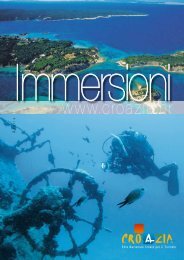Diving
Diving
Diving
Create successful ePaper yourself
Turn your PDF publications into a flip-book with our unique Google optimized e-Paper software.
Along the coast of Pelješac is the wreck of the German torpedo boat<br />
S-57, one of the most interesting in the whole of the Adriatic. This assault<br />
boat (Schnellboote), armed with torpedoes, was at the very peak of the<br />
maritime technology of the times, its powerful construction and small<br />
weight giving it outstanding speed. It was sunk in August 1944 during a<br />
rescue mission searching for the survivors of a German convoy attacked<br />
and destroyed by British torpedo boats. In this operation, which German<br />
commanders named “Operation Hammer”, two ships transporting arms<br />
and medical supplies from Ploče to Dubrovnik – Vega and Dora - were<br />
S-57<br />
lost, as well as the landing craft that accompanied the convoy, which<br />
today lie in the shallow coastal belt, keels uppermost. The oil tanker<br />
Helga managed to return to Korčula, despite damage it suffered, and<br />
informed Dubrovnik of the attack. The following day 5 German torpedo<br />
boats based in Mokošica set out in search of survivors around the coast<br />
of the Pelješac peninsula, and when the British ships attacked again,<br />
S-57 was hit and rendered incapable of manoeuvring and navigating.<br />
Following an unsuccessful attempt to beach the vessel on the nearby<br />
coast, the S-57’s skipper decided to scuttle his vessel so that it would not<br />
fall in Allied hands, and he blew it up right next to the coast of Pelješac.<br />
Two crew members died in this battle and 9 were wounded. Today, the<br />
wreck lies at an ideal diving depth of 20 to 37 m, and in conditions of<br />
generally good visibility. In an average 25 minutes of diving one can enjoy<br />
a reconnaissance of this still armed warship. Its special attraction are the<br />
double-barrelled anti-aircraft cannon on the bow, which still move in their<br />
mountings despite being under the sea for over 50 years. It is possible<br />
that there are still shells in its barrels, and there is also ammunition in<br />
the clips that are still on the cannon. There are two torpedoes on the<br />
deck, and two are in the torpedo tubes on the forward end. In its interior,<br />
however, one can see groupers, sea bass, conger eels and shoals of<br />
Korčula<br />
fish which congregate around the wreck. This is one of the most beautiful<br />
and, as far as filming is concerned, one of the most attractive wrecks in<br />
the Adriatic.<br />
There is also the wreck of the Boka, a ship that ran aground right by the<br />
cost of Pelješac, a pair of German landing craft east of Žuljana, and the<br />
locations of medieval shipwrecks (Pelješac, Korčula).<br />
Lastovo is an island of steep and still quite untamed coast, of<br />
exceptional beauty and clarity of sea. Divers who enjoy the prospect of<br />
free levitation along deep, sunken cliffs will discover how to fulfil their<br />
desires, discovering the deep fissures off the southern cost of the island.<br />
The caves on the SW coast of Korčula (three caves on only 300 m of<br />
coastline, near cape Ključ) and the islet of Bijelac (with an underground<br />
passage through the island) off the NW side of Lastovo, are regarded as<br />
the most attractive locations. The clarity of the sea during calm summer<br />
days enable one to take the best quality underwater photographs here,<br />
which is why the entire area of Lastovo – Korčula – Mljet is the zone most<br />
often visited by experienced divers and by underwater camera operators<br />
and video photographers.<br />
Close to Dubrovnik there are also several wrecks, as well as the attractive<br />
walls of the Elafiti archipelago. In some locations there still exist colonies<br />
of red coral, while in the area of Cavtat there are several shipwreck<br />
sites from the days of Antiquity (sites with amphorae and pithos – grain<br />
containers). Local diving centres are fully capable of organizing diving<br />
excursions to these locations, but the majority of visitors in the area<br />
of Dubrovnik are dependent transport-wise on air links (Ćilipi Airport).<br />
Consequently, due to the relatively poor transport links this area is still<br />
to be developed, and it is expected that once a road is built linking<br />
Dubrovnik to northern parts it will not be long before diving tourists<br />
descend on this pearl of the Croatian Adriatic.<br />
Croatian National Tourist Board 45




